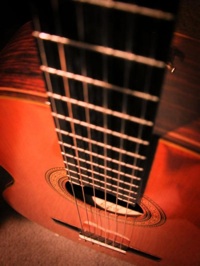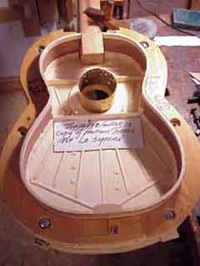Buying a Classical Guitar
So you decide to buy a classical guitar. You walk into the guitar store and see hundreds of guitars hanging on the wall.
But how do you decide which one to buy, there are so many options! You don't want to choose the wrong one. After all, this will be your guitar, you will play it for hundreds - even thousands - of hours.
Unfortunately, most people don't know what to look for when buying a classical guitar. This page will teach you how to choose the ideal guitar for your level, age and price range.
Essentials of Buying a Classical Guitar

The Guitar Should be the Right Size
If you're age 12 or younger, you'll probably buy a classical guitar that is a smaller size. For 5 to 8 year olds, I recommend a 1/2 size classical guitar. And for 9 to 12 year olds, I recommend a 36" student size classical guitar. However, these are just general recommendations. Your guitar should always match your individual height and proportions. You should be able to hold the guitar with correct posture.
No Buzzing Notes
Sometimes, if a guitar is warped, notes on the neck will make a nasty buzzing sound when you play them. Never buy a guitar that has buzzing notes. To check for buzzing notes, play every note on every fret. Do you hear any buzzing sounds? If you are a complete beginner, find someone at the guitar store to help you do this.
It Should Play in Tune
Some guitars will not play in tune because the frets on the neck are poorly aligned. This means that notes in some parts of the guitar play in tune, while notes in other parts of the guitar will not. To check for tuning, use a guitar tuner, and play every note on every fret. Is each note in tune? If you are a complete beginner, find someone at the guitar store to help you do this.
Other Things to Think About

Do you like the sound?
Play a note on the guitar. Do you like the sound? Does it sound full, rich and resonant? This is very subjective - there is no "best" guitar sound. FInd one that you like the most.
Does it have lots of tone colors?
Experiment to find all the different tones you can make on the guitar. What is the warmest tone you can make? The brightest tone? Do you like these different sounds? Some people prefer to play a guitar that makes one very beautiful sound. Others prefer to play a guitar that makes a wide variety of sounds. Which do you prefer?
Is it loud and resonant?
Try to make the loudest sound you can possibly make (without making a buzzing noise). How loud can the guitar play? Classical guitar is very quiet compared to most instruments. Having a louder guitar is useful when you play in concert halls or other public places. A louder guitar projects better and is much easier for an audience to listen hear. But be careful. If the guitar is too loud and resonant, it will sound "messy," with too many sounds ringing at once.
How is the Balance?
Are the high notes louder than the low notes? Most people prefer to have a guitar with a good "balance," so that the high notes and the low notes are about equal.
Is it Easy to Play?
Try playing notes on a few different parts of the fingerboard. Is it easy to press down the notes? An easy guitar is enjoyable and relaxing to play, but is usually less loud than other guitars.
Basics to Know about Guitar Construction

Cedar vs. Spruce Soundboard
The soundboard wood affects how the guitar sounds. Cedar soundboards (darker colored) tend to give the guitar a mellow, darker tone, while emphasizing the lower registers of the sound. Spruce soundboards (lighter colored) tend to give it a brighter, "open," tone while emphasizing the higher registers of the sound.
Wood Quality in Soundboard
Look for a soundboard with many, closely-spaced, grains in the wood. This indicates that the wood is older, will vibrate more easily, and will give the guitar a more resonant sound.
Varnish vs. French Polish
Varnish (a shiny, thick, coating) protects the guitar from scratches and dents, but makes it hard for the soundboard to vibrate. Most inexpensive guitars (less than $2,000) are made with varnish. French polish (thin coat, not as shiny) allows the guitar to vibrate more, making it louder and more resonant.
Body Width
A thick body emphasizes the low registers of the guitar, while a thin body emphasizes the high registers of the guitar.
Neck Width
Some classical guitars have a slightly wider neck than others. Choose a neck width that is most comfortable for your individual hands and fingers.
Guitar Action
The "string action" is the distance from the strings to the fretboard. A high action is harder to play, but can sometimes get a louder sound. A low action is easier to play, but often has a softer sound.
Guitar Pick-Ups
Some classical guitars have a pick-up installed on the inside so that you can plug the guitar into an amplifier. This might be a good option if you want to play a lot of gigs. However, I don't recommend this for most people because a pick-up makes it harder for the soundboard to resonate.
How Much to Spend?
If you're a beginner, I recommend you spend at least $200 to buy a classical guitar. For any less than that, the guitars will be very low quality (unless you're buying a smaller sized guitar). If you are more advanced, I recommend you spend at least $1000.
In general, the more you spend, the more you'll enjoy playing your guitar. So if you're serious about learning, you should put some money into it.
Buy a Classical Guitar That's Right for You!
Take your time when you buy a classical guitar. But don't stress too much. Just follow the guidelines above, and you'll find one that's right for you!
Copyright 2014 © ClassicalGuitar101.org | All Rights Reserved
Popular Articles:
Making a Living as a classical guitarist
List of Classical Guitar Competitions
About Me
My name is Daniel Nelson, and I am a classical guitar teacher and performer from Los Angeles, California. Click here to learn more.
Leave a Comment!